Business.com |
- 5 Pain Points of Small Business Payroll – and How Smart Technology Can Help Solve Them
- Everything E-Commerce Businesses Need to Know About Email Marketing
- How to Draft an Email Newsletter (With templates)
| 5 Pain Points of Small Business Payroll – and How Smart Technology Can Help Solve Them Posted: 29 Mar 2021 04:00 PM PDT Payroll is complex. Tax laws are ever-changing. And paying your people is often last on your to-do list (but first on the list of things that keep you up at night). Luckily, small business payroll systems have come a long way in the last several years. Many of today's payroll platforms have allowed small business owners to move away from tedious and confusing manual processing, with automated payroll increasing accuracy and efficiency. But the best modern payroll solutions don't just automate payroll; they leverage smart technology to make the busy lives of small business owners more convenient and productive. These intelligent payroll systems do more than just keep up – they stay ahead. They get to know your business and your preferences, analyzing them to provide increasingly personalized service. They use data to identify possible improvements to streamline processes. And they tackle tasks for you to eliminate lost or wasted time and free you up to focus on the work that matters most. Indeed, emerging, AI-based technologies are improving on older, more standard payroll platforms' frustrating flaws. That's why we've listed five common pain points of small business payroll and how you can combat these challenges with newer, smarter software platforms. 5 common pain points of small business payrollAs a small business owner, you probably know these common pain points of small business payroll far too well. 1. Payroll is complicated.If only payroll could be as simple as regularly paying your employees fixed amounts. Instead, you have to deduct taxes and perhaps benefits and retirement account contributions from every paycheck. Of course, when paying independent contractors, you won't deduct taxes, but you'll still have tax recordkeeping obligations – you can't forget about 1099-NEC forms. These forms were first introduced in 2020 after decades of 1099-MISC use, and this switch points to a big pain point with payroll: Tax laws never sleep. Their constant changes can make payroll so complicated that you might not even know where to begin. That said, many modern payroll software programs take the painstaking manual number-crunching out of taxes, and some are regularly updated to reflect the newest tax laws. Although these features minimize error and streamline tax calculation and employee payments, they only keep your business on track rather than ahead of the curve. Newer AI-powered payroll apps, on the other hand, learn your payroll inside and out to personalize your service and maximize efficiency and accuracy. This way, your payroll process never misses a beat, and you never have to learn the ins and outs of tax laws – leaving you free to focus on what matters the most for your business. 2. Payroll platforms aren't always user-friendly.Successfully running a business means using all kinds of software platforms to keep your company organized and on track. But that doesn't mean your software is easy to use – and sometimes, payroll platforms are the worst offenders. Despite improved user experiences in recent years, almost all of today's payroll systems still rely on navigational structures that require you to hunt and click through layers of information, with dashboards that aren't all that helpful. You need to know what you're looking for and where to find it, and it's not often intuitive. While today's payroll systems might look nicer than the payroll systems of the past, they still lack familiarity, especially compared to more innovative payroll platforms that leverage modern consumer technology to make paying your people (and other important tasks) easier and faster than ever – in some cases as simple as sending a text. For example, a simple "create 1099" text to your payroll app near-instantly generates your contractor's Form 1099-NEC – no confusing dashboard navigation required. 3. Payroll is time-consuming.Small business owners are always on the go with little time to spare. But it's still very common to have to schedule large blocks of time to sit down and manage payroll. While business success is largely about profit and loss, time is just as important a resource for a small business. That's part of why payroll software first came to be: It saves invaluable time on calculating payroll and storing and accessing employee pay data. However, on the time-savings front, payroll software still lags: An American Payroll Association survey found that one-third of small businesses spend at least six hours per month on payroll. It doesn't have to be this way. Today's most modern payroll apps, powered by AI, are purpose-built for ease, mobility, and flexibility, sending you proactive alerts and allowing you to manage payroll and related tasks with only a few taps on your phone. This means you can pay all your employees in under a minute – and if you're really feeling good, you can give a deserving employee a raise just as quickly. 4. Payroll means admin work.Even if you're not processing payroll manually, paying your people can still be a major administrative burden as employees onboard, offboard or change their information. The burden of entering, updating and maintaining all of that information often falls on the small business owner. Many of today's payroll systems give employees access to software to manage their own information – but just as there's a learning curve for employers with most payroll systems, there's one for employees. That often results in questions and confusion that redirect back to you. This costs you time that you could be using for more strategic work. With smarter, more intuitive payroll platforms that leverage familiar conversational interfaces, your workers can input their own information upon being hired, update information such as their home address and their tax withholdings, view their pay statements, auto-generate their own W-2s, and so much more – all in a matter of seconds via chat interface from their phones. 5. Payroll platforms don't always prevent inaccuracies.Whatever payroll platform you use, you'll likely always worry that somewhere, somehow, the process is going wrong. It's a reasonable worry: Despite the improvements that payroll software has brought to small business operations, the aforementioned American Payroll Association survey found that the IRS levied nearly 5 million payroll tax penalties in 2019. These penalties totaled a whopping $13.7 billion. Tax penalties remain prevalent despite payroll software's omnipresence, because payroll platforms are reactive, not proactive. The big exception is the new class of intelligent, AI-powered payroll tools that learn your payroll so well that they can identify and alert you to flaws before they become problems. With these tools, you can be more confident that you won't misclassify contractors as employees, exclude necessary tax or benefit deductions, or issue inaccurate paychecks. Instead, your payroll operations will be near-perfect – especially if your AI payroll tool is backed by a leading name in payroll compliance and execution. How innovative payroll processing solves these problemsThe problem with today's payroll systems isn't one of comprehensiveness or even automation. Instead, the most critical challenges include a lack of the intelligence, intuitiveness, and flexibility that make processing payroll noticeably faster, easier, and more accurate. Some payroll processing companies have begun rolling out solutions that leverage smart technology to address these challenges. Roll by ADP, for example, uses AI to stay ahead of payroll tasks and deadlines for you. That means more than automated payments come payday – it alerts you when payday is coming up, maintains a timeline of to-dos for you, and even analyzes your payroll in real time and alerts you when it's not in line with your normal payroll run to ensure accuracy. Roll incorporates text-based chat commands to make for an intuitive user experience. The payroll app uses a first-of-its-kind chat-based interface to help you manage payroll and related tasks as easily as sending a text message. For example, as Tax Day approaches, you can generate employee W-2 forms by simply texting "create W-2" in the Roll app. Roll focuses on chat commands over traditional dashboards to make payroll as user-friendly as possible for small businesses like yours. Rather than you logging in to your payroll dashboard from your laptop or desktop, Roll starts the process for you, and with just one or two text commands, you can complete payroll in under a minute right from your phone – no desktop, laptop, or even desk required. Click here to get started with Roll. You'll get more than peace of mind about your payroll; you'll also get time back for everything else. |
| Everything E-Commerce Businesses Need to Know About Email Marketing Posted: 29 Mar 2021 11:44 AM PDT For e-commerce businesses, staying in touch with customers is critical. In today's world, this communication is likely to be entirely digital. That means having a strong email marketing strategy, having the right tools, offering relevant and interactive messages to encourage engagement with your brand, boosting website traffic, and most importantly, increasing conversions. What is e-commerce email marketing?E-commerce email marketing is the practice of using emails to generate sales for your online store. Emails may be one-offs designed to inform your subscribers about a flash sale or specifically targeted campaigns deployed at key moments of a customer journey, but overall, they are meant to build relationships and encourage engagement, and, therefore, they should play an integral role in your marketing team's overall efforts. Consumers' inboxes are inundated with messages day in and day out, so it's crucial to keep your customer (and not your revenue) in mind when curating email campaigns. The final goal is, of course, to drive sales, but if you alienate your audience in the process, all of your hard work will have been in vain. Editor's note: Looking for the right email marketing service for your business? Fill out the below questionnaire to have our vendor partners contact you about your needs. Importance of email marketing for e-commerce businessesEmail marketing is crucial for any organization, but especially so for e-commerce businesses that need a steady stream of traffic to drive conversions. It turns out this type of advertising is effective for many more reasons. Emails are an integral part of daily life, so much so that they tend to heavily affect consumer behavior. According to a recent Hubspot survey, 59% of respondents said that marketing emails influenced their purchasing decisions. The same survey revealed that 73% of millennials prefer communications from businesses to come via email. While this may only be one demographic, it is arguably one of the strongest in terms of buying power and indicates a shift in who is the prime target of messages. Email marketing helps businesses build relationships by offering a 360-degree approach to influencing the three main growth multipliers as identified by marketing authority Jay Abraham. According to Abraham, there's a very simple formula a business must follow to gain revenue: Increase the total number of customers, increase the total number of purchases per customer (purchase frequency) or increase the average order value. Email marketing, especially targeted campaigns triggered by various levels of engagement, can simultaneously affect all three growth multipliers and maximize profits. Below are some examples:
Email marketing is also cost-effective, especially when compared to other digital advertising channels, such as pay per click. A Direct Marketing Association report found email generates $38 in revenue for every $1 spent – that's a 3,800% return on investment. The Hubspot survey mentioned earlier also showed companies that use segmented email campaigns increase revenue by up to 760%. These numbers alone should compel your organization to develop an email marketing strategy, as they indicate the incredible ability of a tool that is relatively easy to deploy. E-commerce email marketing strategies to boost conversionsEffective email marketing doesn't have to be complicated, but there are several initial steps you should take to ensure future success. 1. Choose an email marketing service.The first step to take when starting with email marketing is to pick software to do the heavy lifting for you. There are several reputable and intuitive email marketing services available, many of which offer a full suite of plug-and-play solutions to build and maintain contact lists, design campaigns, automate triggered responses, and measure performance. 2. Build a robust subscriber base.Compelling marketing emails are only effective if they reach the right people. Contact lists contain the email addresses of people who have opted in to receive communications from your company. These lists may also contain pertinent information about the contact and note their place in the customer journey. There are several ways to grow your email list, such as including gated offers on your website (for example, a pop-up box that says, "Sign up for 10% off."), placing calls to action on other platforms like social media, or adding links to employee email signatures. One thing you should never do, though, is purchase an email list, as it will almost always lead to disaster due to the outdated information and spam traps contained in these lists. 3. Segment your contact list.As you build your list, be sure to group similar contacts to target in future campaigns. Known as segmentation, this process is extremely valuable, as it gives subscribers what they're looking for. Create segmented lists based on demographics like location, age, and gender or by their place in the marketing funnel, past buying behavior, or interests. Consider developing unique personas that represent your ideal customers, and assign different segments with their matching profile. 4. Set your objectives.For e-commerce businesses, the goal of email marketing is typically to drive sales. However, it's beneficial for companies to consider setting specific goals and objectives to focus the messaging and streamline campaigns. This may include directing customers to certain products, selecting key segments to target to raise visibility among similar personas or something as simple as boosting the number of quality contacts on your list for future engagement. These goals may change each quarter, but setting an intention for your email marketing campaigns helps you stay on brand and message. Types of e-commerce marketing emailsThere are several different kinds of communications e-commerce operations should include in their email marketing strategies. Here are some of the most useful triggered responses, which you can program to send automatically when a visitor interacts with your site: Welcome emailWelcome emails are sent when a new person registers for your contact list, whether through an opt in or purchase. These emails should thank the subscriber for joining your community, reward them for registering (perhaps by providing a discount code or special offer) and outline what's to come (i.e., how often they can expect to hear from you). Statistically speaking, welcome emails typically generate open rates four times higher than other marketing communications, so make yours count. Opt-in emailEnsuring that your subscribers want to receive your messages not only helps drive sales, but it also prevents deliverability issues. There are two types of opt ins: single and double. A single opt in may occur on your website or in a subsequent email after a purchase is made. A double opt in has an extra step to confirm registration in the form of a dedicated email sent when the first opt in occurs on a website. Double opt ins can be a great way to curate a loyal audience and ensure future emails aren't marked as spam. Curation emailCuration emails are your brand's chance to shine. The idea is to highlight products in your catalog the email recipient would be most likely to purchase based on their previous interactions with your website. Many web service providers allow businesses to track who clicks where, allowing you to add that data to segmented groups in your contact list. For example, if you're an online clothing store selling shirts, pants, coats and shoes and certain visitors tend to only browse the shoes, you'll send targeted curation emails to that specific segment showcasing your best footwear options. Abandoned cart emailIt's an all-too-common story: A prospective customer visits an online store, sees something they are interested in, adds it to their digital shopping bag, but never completes the purchase. You could send an automated email featuring a special offer to help the recipient complete their purchase, such as free shipping or 10% off the items in their cart. Asking for feedback within the abandoned cart email may also bode well, as it shows the customer you care and can help improve barriers to conversion that may exist on your site. Order confirmation emailThis is a fairly straightforward communication but is still worth crafting carefully. Order confirmations, which are essentially digital receipts for e-commerce transactions, can help bolster sales by highlighting similar products and assuring the buyer that they can feel confident in their purchase. You may want to preview what's next in terms of the shipping process, invite feedback or offer a discount on future orders. Thank-you emailThe thank-you note, a blend of a welcome email and an order confirmation, is a time-honored tradition that still resonates in the modern business landscape. Sending a thank-you email when a website visitor signs up for your newsletter or makes a purchase not only shows you care, but it also demonstrates your company's values. You can take the opportunity to express gratitude, offer a reward for loyalty, and share a little bit about the "why" that drives your business. Win-back emailNot everyone who receives your marketing communications may interact with you. For example, you may have a customer who makes one large purchase, opts in to receive your newsletter but then seemingly disappears. Let these distant subscribers know they matter by sending an occasional win-back email specifically catered to their sensibilities. Present a large value to engagement, such as an exclusive discount or buy-one, get-one code, and ensure any featured products match their interests and previous behavior. This may entice them enough to re-engage with your brand. Email newsletterRegularly scheduled communications with your entire contact list can be just as useful as triggered messages, offering near-instant increases in web traffic. Email newsletters inform subscribers about what's new at your company and provide them with useful and relevant content – along with plenty of chances to interact. Consider sending a regular weekly, bi-weekly or monthly newsletter highlighting exciting developments, such as new products or teasing an upcoming sale. Email newsletters are great ways to measure what resonates with your audience, as well as to identify areas in need of improvement to shape future campaigns. Promotional e-blastThe e-blast is another type of mass email capable of boosting your conversion rate. These short and sweet messages convey important information, like the launch of a product, a flash sale or a major change at a company. Email blasts sometimes get a bad reputation for appearing spammy; they can have a remarkable impact on engagement, as long as they're thoughtfully deployed. E-commerce email marketing best practicesThere are several ways to make your email marketing strategy more effective. Here are some tips:
Email marketing toolsAs we mentioned earlier, there are several great email marketing services to choose from. Here are some of our favorites: MailchimpMailchimp is incredibly user-friendly, offering an array of templates, automation tools and analytics. This popular service is great for companies that want to stay in touch with customers without all the bells and whistles. Paid versions offer customer-journey-building capabilities, advanced segmentation and customer support by phone. Constant ContactConstant Contact is a powerful, intuitive platform boasting high deliverability and easy-to-use software. Pricing is based on the size of your list, meaning startups have access to the same tools the big companies have. Constant Contact also offers website building, including e-commerce solutions, as well as other digital advertising options for businesses seeking a one-stop-shop approach. BenchmarkBenchmark is a fantastic option for e-commerce businesses. Its mobile app makes managing marketing emails on the go a breeze while its responsive design function allows users to create stunning communications with little effort. Benchmark's lead generation tool can integrate with your online store to help boost your subscriber base. SendinblueSendinblue offers incredible automation options, a wide selection of templates and guidance on how to avoid spam filters. There are several pricing options perfect for businesses of all types and sizes, including a free version capable of sending up to 300 emails a day with unlimited contacts. |
| How to Draft an Email Newsletter (With templates) Posted: 29 Mar 2021 10:31 AM PDT Effective advertising almost always includes a robust email marketing strategy, regardless of the type of business. Emails are somewhat inexpensive to produce yet reach a wide audience in a quick and efficient way. Using email, you can communicate the latest developments from your company, announce a limited time offer or share your latest blog content. Email newsletters are one of the most common email marketing tools, providing a "one-stop-shop" approach to increasing engagement and conversion. In this guide, we'll explain the benefits of email newsletters and how to craft an effective campaign so you can take your marketing efforts to the next level. What is an email newsletter?An email newsletter is a communication sent on a regular basis that is intended to nurture contacts in an interactive way. They let subscribers know what's new and exciting while simultaneously inviting them to engage with your company. Newsletters should not be overly salesy, as that may alienate your audience. Consider them as a form of "advertainment" – content that should inform consumers about products and services in a fun, approachable way. Newsletters should provide added value for recipients by offering relevant information and deals. Try to put yourself in your customers' shoes: What would you want to know about your company or the industry you are in? For example, if your business sells electronics, featuring exciting news about new innovations may pique readers' interest, thereby increasing the likelihood that they'll read further (and open future communications from you). Editor's note: Looking for the right email marketing service for your business? Fill out the below questionnaire to have our vendor partners contact you about your needs. Why do businesses send email newsletters?There are several benefits you can gain by deploying an email newsletter strategy. First, consistent communications help ensure that companies stay relevant with their subscribers while building rapport. Second, it's a great way to boost website traffic via embedded links to your web content – and, of course, a third benefit of email newsletters is that they help you generate sales. A fourth benefit of sending email newsletters is the relatively low cost associated with production. Aside from labor costs and a subscription fee for an email marketing service, email newsletters are still less expensive than other advertising methods, such as print or pay per click. And with the average American checking their email inbox multiple times throughout the day, you have a higher chance of engaging with your target audience. A fifth benefit of email newsletters is that they provide metrics, which are useful for digital marketing teams to analyze to improve future campaigns. Open rates, click-through rates, and bounce rates are key performance indicators and can provide insight into how subscribers interact with your content. These email analytics are powerful tools, so they should be reviewed regularly to help you increase conversions. How to create an email newsletterCrafting an engaging yet informative email newsletter doesn't have to be difficult. The steps below outline how to create and send a newsletter. (Be sure to read on for the best practices when sending an email newsletter).
Email newsletter best practicesWith so many companies sending email newsletters, it can be challenging to stand out. Here are some best practices to follow that can help you maximize results.
Email newsletter templatesAs we mentioned earlier, most email marketing services offer templates. This allows you to drag and drop images, copy and paste text, and insert buttons for linking to your website. These are some examples of templates in Mailchimp, a popular email marketing software for small businesses, but there are many other types of software out there – see our buying guide to determine which is right for you. Sample No. 1: 'Bold'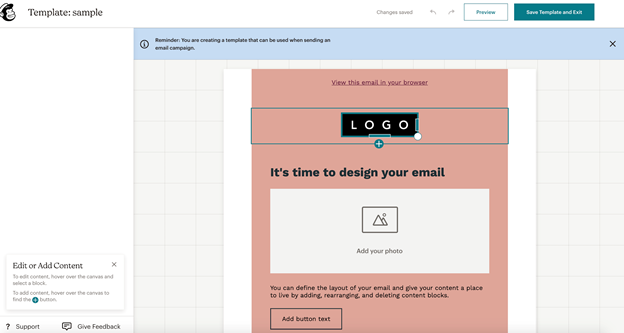 Source: Rocket Science Group Mailchimp makes it extremely simple to customize their templates. This "bold" template (which offers several options for the background color) automatically includes space for your company logo, a headline, image, text, and a button link for a CTA. 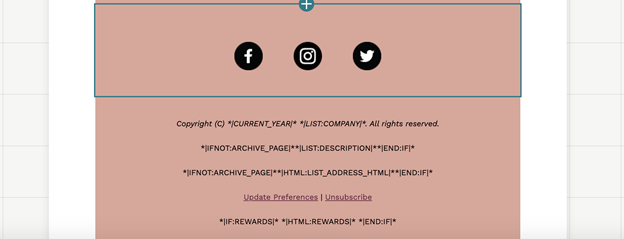 Source: Rocket Science Group Each Mailchimp template also has a place to link to your social media accounts, as well as a footer for pertinent company information and legal disclaimers. You can add content by hovering your mouse where you would like to insert content. A blue plus sign ( "+") will pop up. Click the sign and a menu of content options, such as video, text, photo, etc., appears. Select the asset you want to add, and it will populate into the field. 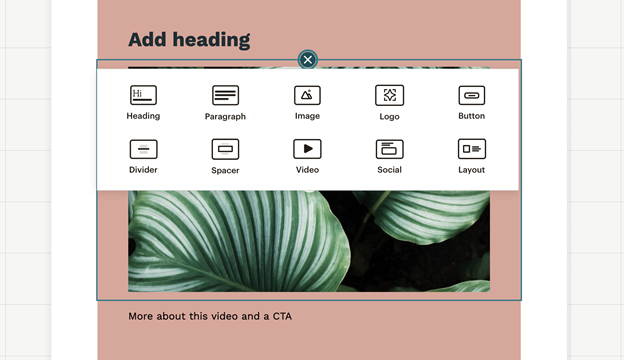 Source: Rocket Science Group Depending on the type of content you want to add, a sidebar may appear, which asks you more questions about the asset, such as the URL you want a button to link to or a description of the video you want to upload.  Source: Rocket Science Group To change the color of the background, hover your mouse over the background, click on it, and you can then choose the color option you prefer. Sample No. 2: 'Natural' Source: Rocket Science Group The natural template is another Mailchimp option. It features muted earth tones, like forest green and sandy tan, that don't distract from your message. Using this template, you drag and drop content blocks to get the configuration you prefer. Sample No. 3: 'Gallery'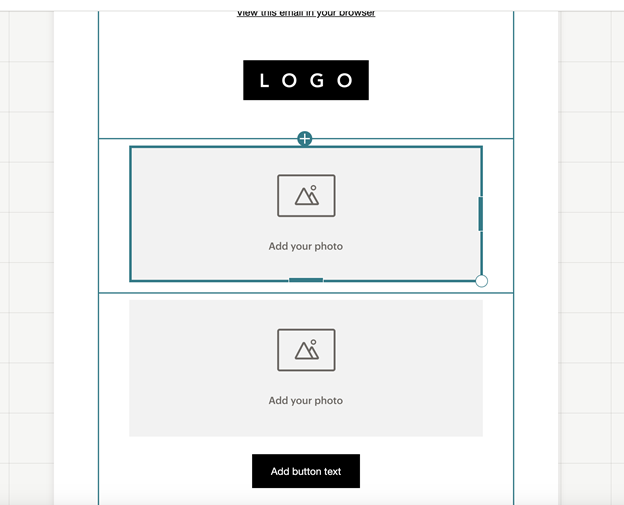 Source: Rocket Science Group Mailchimp's "Gallery" option is a more image-heavy template, perfect for e-commerce companies or media outlets. This template features a white canvas and backdrop to make your pictures pop, but shades of gray, blue, and green are available. Here's how changing the color of the backdrop can instantly change the look and feel of your newsletter: 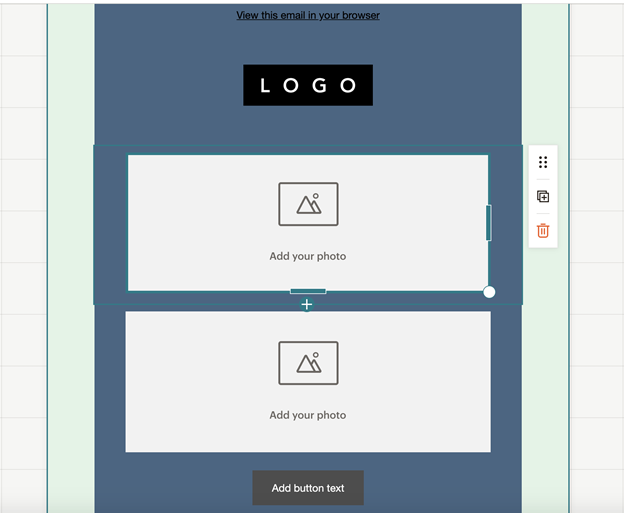 Source: Rocket Science Group Last, make sure you add images to increase interaction and boost conversion. Below is the screen that pops up when you click on "Add your photo." You can choose the alignment of the photo, and if the images are on your company website, you can add the URL. 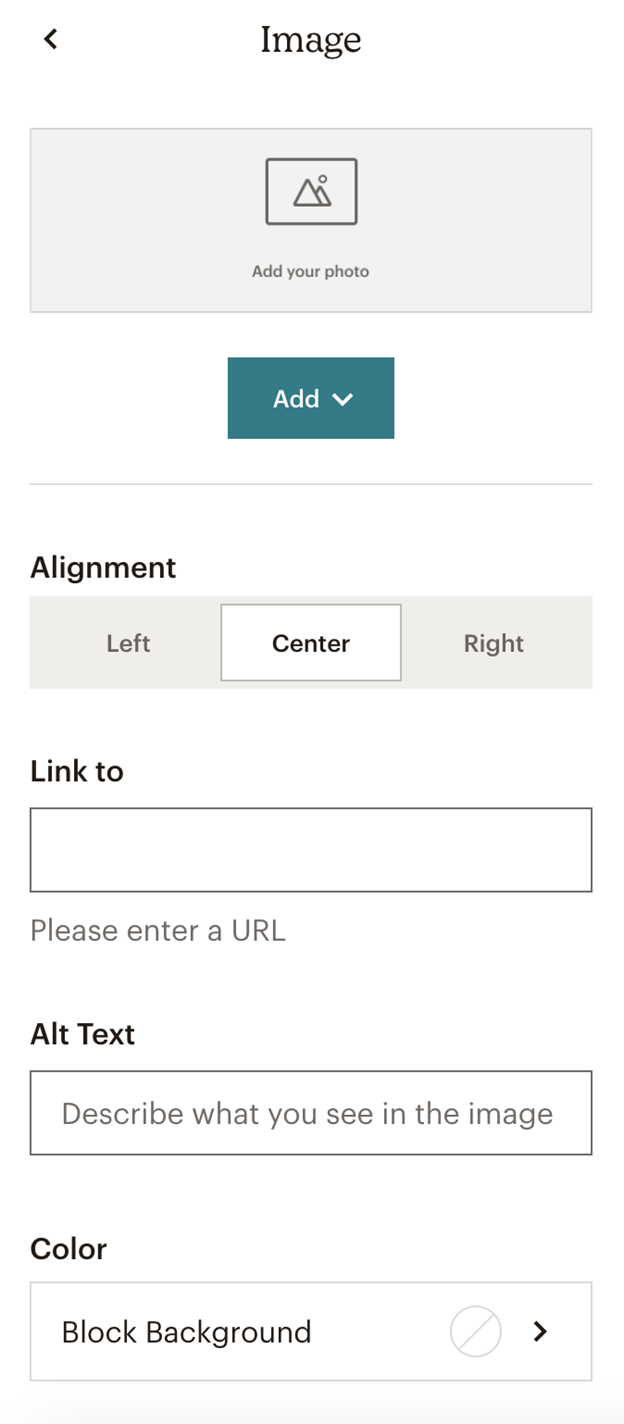 Source: Rocket Science Group |
| You are subscribed to email updates from Business.com. To stop receiving these emails, you may unsubscribe now. | Email delivery powered by Google |
| Google, 1600 Amphitheatre Parkway, Mountain View, CA 94043, United States | |

No comments:
Post a Comment